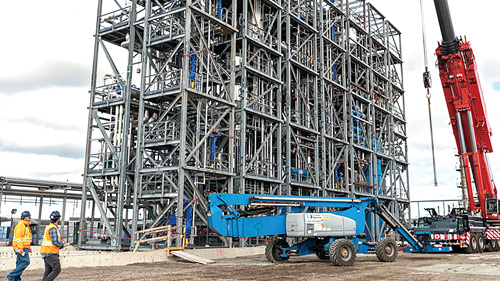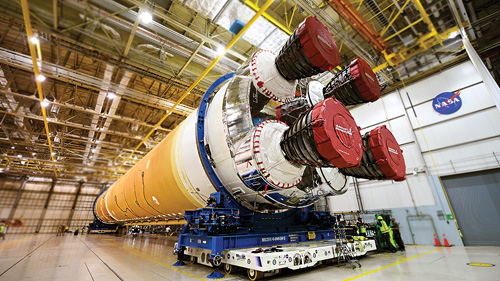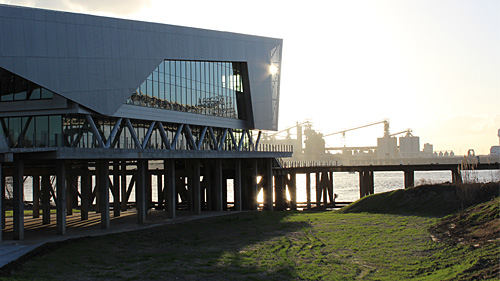No, but it definitely signals an intriguing plot twist. Many outside Louisiana may be unaware of the new chapters the state is writing in this story, answering the challenges of the day with forward-thinking ideas. The state is working to stay ahead of climate change challenges and, as a result, is building expertise that’s valuable globally. And it’s pushing technology advances literally to the moon, and making great strides in medical fields, too.
Altogether, the challenges of the present and future are sparking impressive developments, along the corridor from Baton Rouge to New Orleans, and across the state. Climate change, in particular, promises an extraordinary impact in Louisiana, given the state’s miles and miles of coastline and waterways, its inevitable place in the path of dangerous weather events, and yes, its longtime reliance on a petroleum industry in the crosshairs of change.
“We’re really focused on this new frontier — really beyond America, for all nations — relative to the reduction of greenhouse gases, and how there is an energy transition over the next few decades toward those reductions, all leading to a better environmental stewardship,” says Don Pierson, secretary of Louisiana Economic Development. “We will continue to use fossil fuels, they won’t go away, but we’ll be reducing utilization for refined fuels as we power our cars.”

Pierson says the state is positioned for development of various environmentally friendly technologies. “We anticipate there’ll be a lean toward a hydrogen-powered economy, and we do carbon capture and sequestration. We’re well suited in that we have a geology that supports it and pipelines here that currently carry CO2.”
Louisiana is working to stay ahead of climate change challenges and, as a result, is building expertise that’s valuable globally. Here are a few relatively recent examples of how that trend is playing out today in Louisiana:
- The Greater New Orleans Development Foundation has led development of a proposal called H2theFuture, which is a green hydrogen energy cluster designed to decarbonize the south Louisiana industrial corridor. The project was among five dozen finalists nationally in the federal Build Back Better Regional Challenge. It’s all about moving toward a hydrogen-powered economy and includes creation of the New Energy Institute of America, a clean energy research center and startup incubator. When it was named a finalist, Michael Hecht, GNO’s president and CEO, noted Louisiana’s longstanding leadership in energy: “The H2theFuture plan is the strategy for Louisiana to continue to lead into a lower-carbon future.”
- Air Products is developing a $4.5 billion clean energy complex that will be the world’s largest permanent carbon dioxide sequestration project. It’s designed to produce more than 750 million standard cubic feet per day of “blue hydrogen,” and carbon dioxide from the manufacturing process will be captured and permanently sequestered.
- Renewable diesel projects have been announced by Louisiana Green Fuels and Chalmette Refining, each worth hundreds of millions of dollars and each planning to create diesel fuel from sustainable, renewable sources. The Louisiana Green Fuels plant even promises a production process that would remove more carbon from the environment than it will produce.
- Origin Materials, which calls itself a carbon-negative materials company, has plans to invest at least $750 million developing a biomass manufacturing facility. The plant will utilize sustainable wood residue that comes in part from Louisiana’s timber mills and managed forests in order to make plant-based materials for packaging, textiles, apparel, and other products.
- The Syrah Technologies graphite processing facility is expanding to the tune of more than $175 million. It’s part of the supply chain for electric vehicles, and the expansion will help it supply a component in lithium-ion batteries.

Climate challenges have already had a significant impact on life in Louisiana. In particular, the 2005 hurricanes Katrina and Rita caused devastation across the southern part of the state and underscored the threats facing those along and near the Gulf Coast. State leaders stepped up their focus on coastal restoration, protection, and resilience.
What emerged a few years later was the Water Institute of the Gulf, a collaborative effort involving the state, former U.S. Sen. Mary Landrieu, and the Baton Rouge Area Foundation. The idea was to dive into the climate challenges facing Louisiana’s coastal landscapes, bring together researchers at all levels, and ultimately build a knowledge base that would not only help the state prepare for future resiliency, but also create insights that could be exported globally.
Secretary Pierson says the state is positioned for development of various environmentally friendly technologies. Pierson calls water management an emerging element in the state’s economy. “It’s certainly important here in Louisiana due to global warming, with lost acres of land to subsidence,” he says, adding that the state has identified financial resources to help build expertise and knowledge in water management, coastal protection, and restoration. “We’ve directed resources coming to us from offshore oil royalties. It’s not only a scientific exercise but one that is powered by an ongoing revenue stream that allows us to take action,” he says.
Among many other activities, the Water Institute was involved in the creation of the state’s first Climate Action Plan, announced by Gov. John Bel Edward back in January, the first of its kinds in the Gulf South. The plan aims to limit the severity of climate change while maintaining economic competitiveness as the future becomes more and more low-carbon. “Our team was able to provide the task force with both qualitative and quantitative information across a wide swath of metrics and objectives to help inform their deliberations within a fast-moving planning process,” according to Alyssa Dausman, the institute’s senior vice president and chief scientist.
Satisfying Workforce Needs
Beyond that strong focus on planet earth, Louisiana also has set its sights solidly on returning humans to the moon. The National Aeronautics and Space Administration is preparing to launch a test flight in the Artemis program this year, and the core stage of that Space Launch System rocket was produced at NASA’s Michoud Assembly Facility in New Orleans.
Needless to say, this is not your everyday manufacturing — it’s rocket science, in fact. The state’s LED FastStart program is helping with workforce development needs, according to FastStart’s executive director, Paul Helton. “NASA’s Artemis mission is a great example of the level of sophistication, customization, and long-term support that LED FastStart provides to our partner companies,” he says.
FastStart was engaged to meet short-term training and recruitment needs along with building a long-term workforce pipeline for Boeing’s Space Launch System project. “We led a team that included the Louisiana Community and Technical College System and Nunez Community College to benchmark other educational programs supporting NASA operations across the country,” Helton says.
Nunez Community College is equipped to provide a trained workforce for Boeing and all of the other partners at Michoud. Pierson says it’s a source of pride to have such a key component of the space program taking flight from Louisiana. “We’d like to think on the side of that rocket would be a logo that says ‘Cajun-certified.’”

Back on earth, Louisiana is tapping into its strong resources in healthcare and life sciences R&D. As with activities related to climate change, it’s part a focus on future opportunities and part a response to current challenges — COVID-19, for example.
Louisiana State University’s Health and Sciences Center in New Orleans was early to the work of studying COVID deaths as the pandemic first began. In early April 2020, researchers there discovered that blood vessels in patients’ lungs were filled with clots. The discovery was so alarming and foundational that the Louisiana researchers pushed out a preprint version of their study, which had an immediate and positive impact on the treatments used by doctors across the country.
In Baton Rouge, the community has seen half a billion dollars in health infrastructure investment in the past five years, according to Steven Ceulemans, executive director of the Baton Rouge Health District. The district is pushing innovation forward on a number of fronts.
State leaders stepped up their focus on coastal restoration, protection, and resilience. “We received U.S. Economic Development Administration funding for a regional innovation cluster program called the Louisiana HealthTech Catalyst,” Ceulemans says. It will help create synergies between major health-related anchors.
He adds that the foundation is part of the Gulf Coast Health Sciences Corridor, which was another of the 60 national finalists in the Build Back Better Regional Challenge. “The two key Baton Rouge projects for our cluster include a new Innovation Center at Pennington Biomedical Research Center and a district gateway enhancement initiative to promote continuity and cohesion between our major health campuses.”
The Gulf Coast Health Sciences Corridor proposal was pulled together by the New Orleans BioInnovation Center. It aims to make strategic investments in health science industries along with workforce development targeted at women, rural residents, and people of color.
Meanwhile, LSU’s Pennington Biomedical Research Center is emerging as a leader in treatment of obesity. It is home to the nation’s first integrated, interdisciplinary metabolic treatment center. The Bariatric & Metabolic Institute, recently renamed the Metamor Institute, aims to transform the understanding and treatment of obesity. According to Pennington’s executive director, John Kirwan, “Metamor is our obesity ‘moonshot.’”
Amid all of this activity, Pierson says the state maintains its focus on its traditional sectors, even as they evolve. Agriculture is an ongoing source of pride, along with advanced manufacturing. And then there’s forestry, an age-old sector that is gaining efficiencies from computerized sawmills and processes that retain byproducts for such things as renewable-energy wood pellets — some of which are shipped overseas to produce electricity. Says Pierson, “We haven’t taken our eyes off the ball.”




